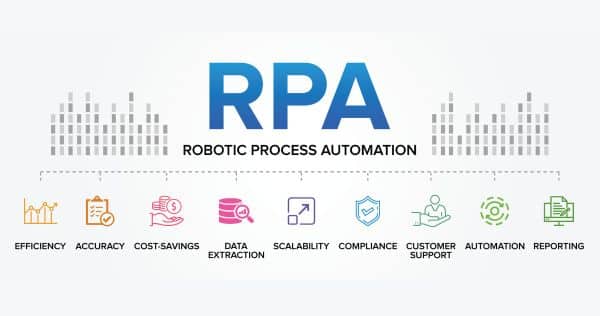Supply chain management has surpassed the old model of manual, human-driven tasks. In today’s fast-paced world, the supply chain logistics industry is leaning into technology to decrease human error, optimize practices, and boost efficiency for business growth. In order to remain competitive, organizations are actively searching for transformative technological tools that pair value with ROI.
Enter RPA or Robotic Process Automation. RPA automates processes and tasks using trained bots, leaving more space for businesses to focus human efforts on innovation, strategy, and business success.
The RPA market grows exponentially every year. Based on forecasts, by 2030 it will dominate at $13.39 Billion in size. It’s no wonder that, according to Deloitte’s Global Robotics Survey (2018), 53% of companies have already started their RPA journey, and at the current level of growth, RPA will be near-universally adopted within the next five years. 78% of organizations that have implemented RPA are planning to continue the investment at significantly higher rates.
While RPA technology is not new, its application for the supply chain and logistics sector is only recently coming into its own. In the next decade, robotics and animation are estimated to be among the top 87% of technologies that will impact the supply chain, as technology adoption rates exponentially increase. The usability of these types of tools in procurement and logistics is increasing on average 11.43% annually, a trend that suggests that, if it isn’t already, automation should be a priority for supply chain companies.
Even with its relative novelty, we’re already seeing best practices, use cases, and benefits of using RPA in the supply chain. Consider this deep dive a guide to RPA: what it is, why it matters, and how it can benefit businesses in supply chain and logistics.
What exactly is RPA, and how does it work?
Robotic Process Automation uses software to automate processes that have traditionally been performed by humans. Instead of a person, you train a robot on a set of specific instructions on rule- and trigger-based tasks to perform. RPA is about error-free, high-speed, reliable, and scalable performance.
The ideal process candidates for RPA implementation are:
- Rule-based
- Regularly repeated or trigger-based
- Defined input and outputs
- High Volume
Between automation, knowledge management, and analysis for self-learning and development, supply chain companies have a unique opportunity to capitalize on RPA at all levels of operations.
RPA in Supply Chain and Logistics
Luckily, there is no shortage of possible use cases of RPA. Consider these:
Purchasing and supply management
- Create, verify, and send requests for quotations. Convert into purchase orders.
- Manage inventory (availability, alerts, automatically replenish items)
Production and logistics
- Monitor order fulfillment. Track shipping, transportation, and delivery\
- Process receipts and invoices, work orders, accounting and financials
Client relationships
- Automate low-level customer inquiries
- Automated feedback collection
Strategy
- Predict trends in supply and demand
- Collect sales and market research data
Why Choose RPA? Outcomes and Benefits
Here are 3 major considerations that decision-makers can take into account when exploring RPA.
- Speed and Reliability with minimal error
Robots are not human = capacity and speed
Humans are not perfect. For any number of reasons—tiredness, distractions—we introduce error potential into any process. Robots don’t face the same challenges. After training, you gain a fully functional 24-hour operating bot to perform tasks at a rate that meets the high demand and expectation of the industry. Companies experience the benefits almost immediately, receiving an average of 20% full-time equivalent capacity thanks to robots.
Less error = quality and accuracy
RPA also guarantees an almost complete error-free result. According to RPA users, quality and accuracy improve by 90%. In fact, RPA even makes it easier to locate existing process errors. In supply and logistics, this reduces the so-called “bullwhip effect”: supply chain inefficiencies because of poor demand forecasts and communication up and downstream.
Clearly defined = compliance
According to 92% of manufacturers, RPA improved compliance. Bots can be instructed to follow the rules and regulations provided to them, giving companies peace of mind that policies are being enacted properly.
- Low barrier to entry, high return on investment
A worthy ROI
Relative to the huge value-add, RPA is cheap, fast, and flexible to launch. Research indicates that up to 45% of business activities can potentially be automated, which translates into $2 Trillion saved in global labor costs. Companies using RPA have experienced cost reductions by up to 59%. According to one study, acquisition costs paid off within the first project, only taking a month to implement. Once established, future projects could be implemented at even faster rates.
Easy on IT
RPA is an example of “lightweight IT” because it does not require significant modification to existing IT systems and runs on any software or platform, including web-based, ERP systems, and mainframes. This makes it possible to bridge functionality gaps and multi-interfaces. It’s also easy to use, and requires little to no programming skills.
- More strategic and cost-effective labor
Less human labor on tasks that can be automated.
Organizations and industries making the switch to RPA are more likely to experience a 43% deduction in human resources needed. Manual data entry tasks traditionally performed by humans go down by 65-80%. Licenses for bots are significantly cheaper than labor costs, with the added benefit of flexibility for scaling. For companies who experience squeeze from the outsourcing and costly investment in human labor, this means less salaries to take on.
Freed-up human resources allow existing employees to refocus their attention and experience a higher quality of work experience.
Companies who have integrated RPA describe shifting from reactivity into proactivity, thinking big-picture about how to make the business competitive. 34% of workers in companies using intelligent automation notice changes in their roles and ways of working, including higher productivity and more focus on high-value items. Rather than spending precious time and energy on necessary but low-value processes, workers focus on strategic priorities such as innovation, creative exploration, and future-forward growth planning.
Simultaneously, with automation freeing up 60% of working time, employees are less likely to experience burnout and more likely to report satisfaction with their jobs. Your best people work on what they do best while feeling their best: it’s an ideal scenario.
Insights and analysis support strategy.
RPA supports your business’ strategic growth through data collection and analysis.
RPA gives you insight into not only your company’s performance and business metrics, but it also tells you about stakeholder behaviors. More sophisticated analysis, and combining RPA with AI or Natural Language Processing tools, open up even more opportunities.
Ensuring RPA Success. Where to begin?
All in all, RPA has a clear benefit and use case for companies in supply chain and logistics. That said, integrating a new technology will come with its own challenges. Luckily, between research and experience, we know what works (and doesn’t work) for RPA. Consider these conditions for success.
- A well-developed digitalization plan. What software will you select? What are the project milestones? What are the roles and responsibilities of the people involved?
- Smart process selection. Not every process is RPA-friendly. What processes are the most suitable based on function, value, and feasibility?
- Buy-in and involvement by management and leadership. The tone starts at the top. RPA first needs leadership support and then needs to involve all necessary decision-makers at all organizational levels.
- Strong change management strategy. People resist change. How will you get people to adopt new processes, roles, changing tasks, or fears? How will you promote the RPA internally and externally?
- Oversight. You still need some human capital to implement the technology, supervise/coordinate expertise across domains, and consider logistical items like government regulations, licenses, and bot maintenance.
Diving into a new adventure is both thrilling and overwhelming for companies. RPA is an exciting tool to explore in the supply chain world, but it’s still new. Consider bringing in experts to guide you along the journey and maximize your results.
If you’re considering RPA for your company, contact us for more information. We are here to support you (and your robots) every step of the way.




